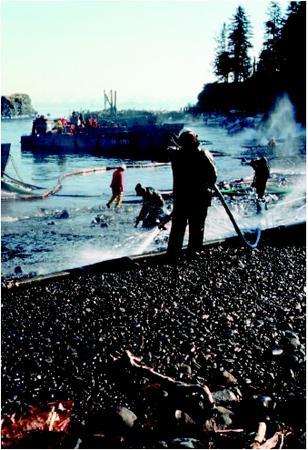There is a range of regulations and strategies in place to control environmental pollution and emissions from most major industries.
Implementation of pollution control regulations is primarily the responsibility of the Scottish Environment Protection Agency and local authorities.Air pollution, both indoor and outdoor, is a significant cause of health problems worldwide. Urban and rural outdoor environments contain infections, allergens, irritants and chemical toxins that can reduce the quality of life and cause disease. Inhaled air pollution is directed at the the nose, throat and lungs. The exposed airway allows hazardous pollutants to enter the body and all tissues are ultimately exposed.
Airborne chemicals contaminate food and water. They may be ingested and are also collected in the nose and throat and swallowed, often in mucus that attempts to protect exposed surfaces. Airborne chemicals entering the digestive system include well-known toxins such as pesticides, organophosphate, PCBs, dioxin, arsenic, cadmium, lead, and mercury. In addition occupational exposures to airborne pathogens can be intense and can cause cancer. While ambient air pollution is a major concern, indoor air can be more polluted than outdoor air. Building materials and furnishings are a source of volatile chemicals. A decrease in indoor air quality is the result of reduced ventilation and efficient construction practices, sealing homes and office buildings from the outdoor environment .Air pollution, both indoor and outdoor, is a significant cause of health problems worldwide. Urban and rural outdoor environments contain infections, allergens, irritants and chemical toxins that can reduce the quality of life and cause disease. Inhaled air pollution is directed at the the nose, throat and lungs. The exposed airway allows hazardous pollutants to enter the body and all tissues are ultimately exposed.
Airborne chemicals contaminate food and water. They may be ingested and are also collected in the nose and throat and swallowed, often in mucus that attempts to protect exposed surfaces. Airborne chemicals entering the digestive system include well-known toxins such as pesticides, organophosphate, PCBs, dioxin, arsenic, cadmium, lead, and mercury. In addition occupational exposures to airborne pathogens can be intense and can cause cancer. While ambient air pollution is a major concern, indoor air can be more polluted than outdoor air. Building materials and furnishings are a source of volatile chemicals. A decrease in indoor air quality is the result of reduced ventilation and efficient construction practices, sealing homes and office buildings from the outdoor environment


Nowadays, environmental issue is the key topic worldwide.
The advanced countries as well as developing countries have big concern about environmental pollution and put their utmost efforts to protect and preserve their green environment.
Everyday, we produce some kinds of wastes. Households generate ordinary garbage. Industrial and manufacturing process generates both solid waste and hazardous waste.
Especially, plastic packaging material is the main polluter which contaminates human environment.
Recycling can help solving out the problem by reducing the quantities of solid waste deposited in landfills, which have become increasingly expensive.
Recycling also reduces the pollution of air, water and land resulting from waste disposal. Since 1983, JOONGBO has created technology and tools for recycling waste of house hold and industry.
We aim to protect us from the hazards of waste disposal ; conserve energy and natural resources by developing recycling technology